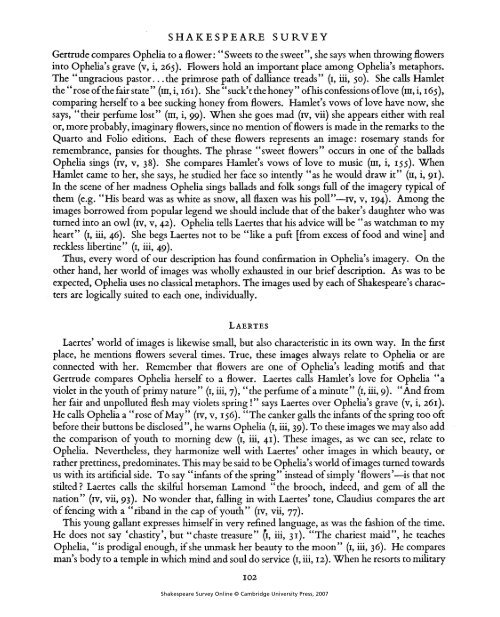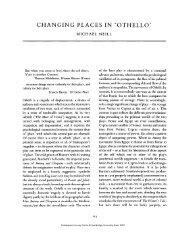the individualization of shakespeare's characters through imagery
the individualization of shakespeare's characters through imagery
the individualization of shakespeare's characters through imagery
You also want an ePaper? Increase the reach of your titles
YUMPU automatically turns print PDFs into web optimized ePapers that Google loves.
SHAKESPEARE SURVEY<br />
Gertrude compares Ophelia to a flower: " Sweets to <strong>the</strong> sweet", she says when throwing flowers<br />
into Ophelia's grave (v, i, 265). Flowers hold an important place among Ophelia's metaphors.<br />
The "ungracious pastor.. .<strong>the</strong> primrose path <strong>of</strong> dalliance treads" (1, iii, 50). She calls Hamlet<br />
<strong>the</strong>" rose <strong>of</strong><strong>the</strong> fair state" (ni,i, 161). She "suck't <strong>the</strong> honey "<strong>of</strong> his confessions <strong>of</strong> love (m,i, 165),<br />
comparing herself to a bee sucking honey from flowers. Hamlet's vows <strong>of</strong> love have now, she<br />
says, "<strong>the</strong>ir perfume lost" (m, i, 99). When she goes mad (iv, vii) she appears ei<strong>the</strong>r with real<br />
or, more probably, imaginary flowers, since no mention <strong>of</strong> flowers is made in <strong>the</strong> remarks to <strong>the</strong><br />
Quarto and Folio editions. Each <strong>of</strong> <strong>the</strong>se flowers represents an image: rosemary stands for<br />
remembrance, pansies for thoughts. The phrase "sweet flowers" occurs in one <strong>of</strong> <strong>the</strong> ballads<br />
Ophelia sings (iv, v, 38). She compares Hamlet's vows <strong>of</strong> love to music (m, i, 155). When<br />
Hamlet came to her, she says, he studied her face so intently "as he would draw it" (n, i, 91).<br />
In <strong>the</strong> scene <strong>of</strong> her madness Ophelia sings ballads and folk songs full <strong>of</strong> <strong>the</strong> <strong>imagery</strong> typical <strong>of</strong><br />
<strong>the</strong>m (e.g. "His beard was as white as snow, all flaxen was his poll"—iv, v, 194). Among <strong>the</strong><br />
images borrowed from popular legend we should include that <strong>of</strong> <strong>the</strong> baker's daughter who was<br />
turned into an owl (iv, v, 42). Ophelia tells Laertes that his advice will be "as watchman to my<br />
heart" (1, iii, 46). She begs Laertes not to be "like a puft [from excess <strong>of</strong> food and wine] and<br />
reckless libertine" (1, iii, 49).<br />
Thus, every word <strong>of</strong> our description has found confirmation in Ophelia's <strong>imagery</strong>. On <strong>the</strong><br />
o<strong>the</strong>r hand, her world <strong>of</strong> images was wholly exhausted in our brief description. As was to be<br />
expected, Ophelia uses no classical metaphors. The images used by each <strong>of</strong> Shakespeare's <strong>characters</strong><br />
are logically suited to each one, individually.<br />
LAERTES<br />
Laertes' world <strong>of</strong> images is likewise small, but also characteristic in its own way. In <strong>the</strong> first<br />
place, he mentions flowers several times. True, <strong>the</strong>se images always relate to Ophelia or are<br />
connected with her. Remember that flowers are one <strong>of</strong> Ophelia's leading motifs and that<br />
Gertrude compares Ophelia herself to a flower. Laertes calls Hamlet's love for Ophelia "a<br />
violet in <strong>the</strong> youth <strong>of</strong> primy nature" (1, iii, 7), "<strong>the</strong> perfume <strong>of</strong> a minute" (1, iii, 9). "And from<br />
her fair and unpolluted flesh may violets spring !" says Laertes over Ophelia's grave (v, i, 261).<br />
He calls Ophelia a "rose <strong>of</strong> May " (iv, v, 156). "The canker galls <strong>the</strong> infants <strong>of</strong> <strong>the</strong> spring too <strong>of</strong>t<br />
before <strong>the</strong>ir buttons be disclosed", he warns Ophelia (1, iii, 39). To <strong>the</strong>se images we may also add<br />
<strong>the</strong> comparison <strong>of</strong> youth to morning dew (1, iii, 41). These images, as we can see, relate to<br />
Ophelia. Never<strong>the</strong>less, <strong>the</strong>y harmonize well with Laertes' o<strong>the</strong>r images in which beauty, or<br />
ra<strong>the</strong>r prettiness, predominates. This may be said to be Ophelia's world <strong>of</strong> images turned towards<br />
us with its artificial side. To say "infants <strong>of</strong> <strong>the</strong> spring" instead <strong>of</strong> simply 'flowers'—is that not<br />
stilted? Laertes calls <strong>the</strong> skilful horseman Lamond "<strong>the</strong> brooch, indeed, and gem <strong>of</strong> all <strong>the</strong><br />
nation" (iv, vii, 93). No wonder that, falling in with Laertes' tone, Claudius compares <strong>the</strong> art<br />
<strong>of</strong> fencing with a "riband in <strong>the</strong> cap <strong>of</strong> youth" (iv, vii, 77).<br />
This young gallant expresses himself in very refined language, as was <strong>the</strong> fashion <strong>of</strong> <strong>the</strong> time.<br />
He does not say 'chastity', but "chaste treasure" (1, iii, 31). "The chariest maid", he teaches<br />
Ophelia, "is prodigal enough, if she unmask her beauty to <strong>the</strong> moon" (1, iii, 36). He compares<br />
man's body to a temple in which mind and soul do service (1, iii, 12). When he resorts to military<br />
102<br />
Shakespeare Survey Online © Cambridge University Press, 2007



